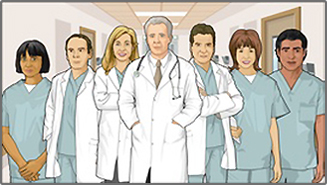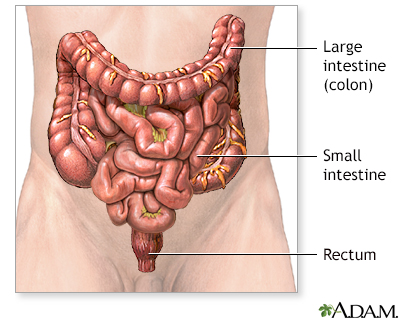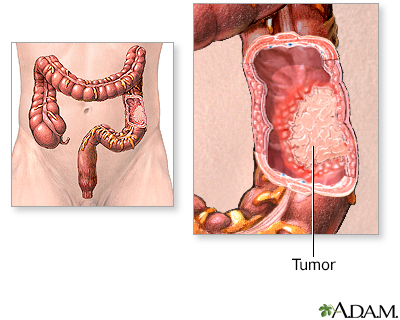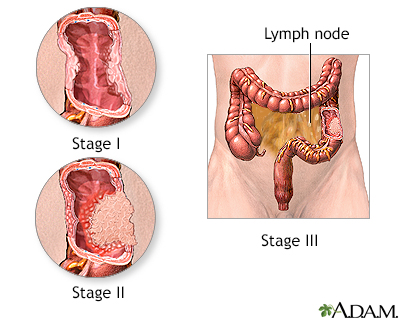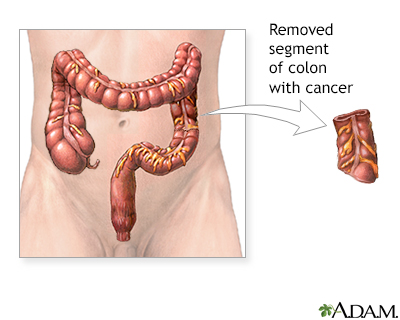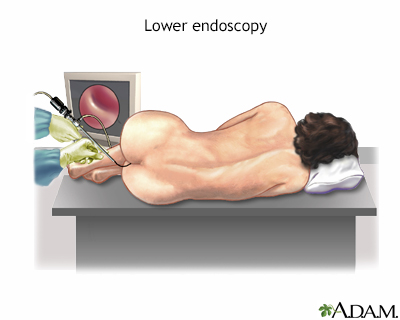Cancer
Cancer is the uncontrolled growth of abnormal cells in the body. Cancerous cells are also called malignant cells.
Causes
Cancer is made of cells in the body. Normal cells multiply when the body needs them, and die when they are damaged or the body doesn't need them.
Cancer occurs when the genetic material of a cell becomes changed. This results in cells growing out of control. Cells divide too quickly and do not die in a normal way.
There are many kinds of cancer. Cancer can develop in almost any organ or tissue, such as the lung, colon, breast, skin, bones, or nerve tissue.
There are many risk factors for cancer, including:
- Smoking tobacco or other substances
- Chewing tobacco
- Benzene and other chemical exposures
- Drinking too much alcohol
Alcohol
Beer, wine, and liquor all contain alcohol (ethanol). Drinking an excessive amount of alcohol can put you at risk for alcohol-related problems....
 ImageRead Article Now Book Mark Article
ImageRead Article Now Book Mark Article - Environmental toxins, such as certain poisonous mushrooms and a type of mold that can grow on peanut plants and produce a toxin called aflatoxin
- Genetic problems
- Obesity
- Radiation exposure
- Too much sunlight exposure
- Viruses
The cause of many cancers remains unknown.
The most common cause of cancer-related death is lung cancer.
In the United States, skin cancer followed by breast cancer are the most commonly diagnosed cancers.
In US men, other than skin cancer, the three most common cancers are:
- Prostate cancer
Prostate cancer
Prostate cancer is cancer that starts in the prostate gland. The prostate is a small, walnut-shaped structure that makes up part of a man's reproduc...
 ImageRead Article Now Book Mark Article
ImageRead Article Now Book Mark Article - Lung cancer
Lung cancer
Small cell lung cancer (SCLC) is a fast-growing type of lung cancer. It spreads much more quickly than non-small cell lung cancer. There are two typ...
 ImageRead Article Now Book Mark Article
ImageRead Article Now Book Mark Article - Colorectal cancer
Colorectal cancer
Colorectal cancer is cancer that starts in the large intestine (colon) or the rectum (end of the colon). It is also sometimes simply called colon ca...
 ImageRead Article Now Book Mark Article
ImageRead Article Now Book Mark Article
Video Transcript
Prostate cancer - Animation
As men get older, they have a lot of new worries to deal with, from hair loss, weight gain, perhaps even erectile dysfunction. In addition, cancer is one of the biggest concerns that older men face, especially prostate cancer, which is the leading cause of cancer death in men over 75. Younger men may not be very familiar with their prostate, the walnut-shaped gland that wraps around the urethra, the tube that carries urine out of the body. But as they get older, the prostate can start to cause problems. Men over the age of 60 are at increased risk for prostate cancer, especially if they're of African descent, they have a father or brother with the disease, or they eat a lot of burgers and processed meats in their daily diet. It can be hard to pinpoint prostate cancer symptoms, because they usually start late in the disease and they can mimic symptoms of a benign, enlarged prostate, which is also more common in older men. Symptoms like a slow urine stream, dribbling, blood in the urine, or straining while urinating can be signs of either condition. An enlarged prostate can also confuse the results of a PSA test, which is used to screen for prostate cancer. So, if your doctor thinks you might have prostate cancer, you may need a biopsy, which is a procedure that removes a small piece of prostate tissue and sends it to the lab to check for cancer. Then a scoring system called the Gleason grade is used to tell how fast your cancer might spread. Your Gleason grade will help decide what treatment you get. Early-stage prostate cancers that haven't spread are often removed with surgery, and then treated with radiation therapy to kill any remaining cancer cells. Prostate cancer surgery may affect your ability to have sex and control urine, so talk about these issues with your doctor before you have the procedure. Because prostate cancer tends to grow very slowly, your doctor may want to just monitor you with PSA tests and biopsies, and avoid treatment unless the cancer starts to spread. Prostate cancer that has spread is usually treated with surgery, chemotherapy, or hormone therapy. If your doctor discovers prostate cancer in its early stages, before it spreads, it's pretty easy to treat, and even cure. Treatments can also slow down prostate cancer that's spread, and extend your survival. Before you have to deal with a prostate cancer diagnosis, ask your doctor for ways to prevent and screen for the disease. Eating a healthy, low-fat diet that's high in healthy omega-3 fatty acids might help lower your risk. There are also drugs called finasteride and dutasteride that are used in some men to prevent prostate cancer. Talk with your doctor about the pros and cons of these drugs, as well as the possible benefits and risks of having your PSA levels tested.
In US women, other than skin cancer, the three most common cancers are:
- Breast cancer
Breast cancer
Breast cancer is cancer that starts in the tissues of the breast. There are two main types of breast cancer:Ductal carcinoma starts in the tubes (du...
 ImageRead Article Now Book Mark Article
ImageRead Article Now Book Mark Article - Lung cancer
- Colorectal cancer
Video Transcript
Breast cancer - Animation
Of all the different types of cancers, breast cancer is one of the most talked about, and with good reason. One out of every eight women will develop breast cancer sometime in their life. That's why every woman should be thinking about how to protect herself from this disease. Breast cancer is cancer that forms in the breast. Usually, it begins in the tubes that transport milk from the breast to the nipple. If the cancer spreads to other parts of the breast or body, it's called invasive breast cancer. Some breast cancers are more aggressive, growing more quickly than others. Although women are 100 times more likely to develop breast cancer, men can also get the disease because they do have breast tissue. You're more likely to get breast cancer if you're over 50, you started your periods before age 12, or you have a close family member with the disease. Drinking more than a couple of glasses of alcohol a day and using hormone replacement therapy for several years also may increase your risk. The telltale sign of breast cancer is a lump in your breast or armpit. You may also notice a change in the shape, size, or texture of your breast, or have fluid coming from your nipple when you're not breastfeeding. If you notice any changes in your breasts, call your doctor. You'll probably need to have an imaging scan, such as a mammogram, MRI, or ultrasound. A piece of tissue may be removed from your breast, called a biopsy. With these tests, your doctor can tell whether you have breast cancer, and if so, determine whether or not it has spread. So, how do we treat breast cancer? That really depends on the type of cancer, and how quickly it's spreading. Your doctor may recommend that you have the cancer removed with surgery. Sometimes it's enough just to remove the lump. That's called a lumpectomy. In other cases, the doctor will need to remove the entire breast to get rid of all the cancer or prevent it from coming back. That's called a mastectomy. Other treatments for breast cancer include chemotherapy, medicines that kill cancer cells, and radiation therapy, which uses energy to destroy cancer. Women whose cancer is fueled by the hormone estrogen may receive hormone therapy to block the effects of estrogen on their cancer. Today's breast cancer treatments are better than ever. Many women who have breast cancer go on to live long, healthy lives. The outlook really depends on how fast the tumor is growing, and how far it has spread. That's why it's so important to report any changes in your breasts to your doctor as soon as you notice them. Women who are at an especially high risk for breast cancer because of their family history can talk to their doctor about taking medicine or even having surgery to reduce their risk.
Some cancers are more common in certain parts of the world. For example, in Japan, there are many cases of stomach cancer. But in the United States this type of cancer is much less common. Differences in diet or environmental factors may play a role.
Stomach cancer
Stomach cancer is cancer that starts in the stomach.

Some other types of cancer include:
- Brain cancer
Brain cancer
A primary brain tumor is a group (mass) of abnormal cells that start in the brain.
 ImageRead Article Now Book Mark Article
ImageRead Article Now Book Mark Article - Cervical cancer
Cervical cancer
Cervical cancer is cancer that starts in the cervix. The cervix is the lower part of the uterus (womb) that opens at the top of the vagina.
 ImageRead Article Now Book Mark Article
ImageRead Article Now Book Mark Article - Hodgkin lymphoma
Hodgkin lymphoma
Hodgkin lymphoma is a cancer of lymph tissue. Lymph tissue is found in the lymph nodes, spleen, liver, bone marrow, and other sites.
 ImageRead Article Now Book Mark Article
ImageRead Article Now Book Mark Article - Kidney cancer
Kidney cancer
Renal cell carcinoma is a type of kidney cancer that starts in the lining of very small tubes (tubules) in the kidney.
 ImageRead Article Now Book Mark Article
ImageRead Article Now Book Mark Article - Leukemia
Leukemia
Leukemia is a type of blood cancer that begins in the bone marrow. Bone marrow is the soft tissue in the center of the bones, where blood cells are ...
 ImageRead Article Now Book Mark Article
ImageRead Article Now Book Mark Article - Liver cancer
Liver cancer
Hepatocellular carcinoma is cancer that starts in the liver.
 ImageRead Article Now Book Mark Article
ImageRead Article Now Book Mark Article - Non-Hodgkin lymphoma
Non-Hodgkin lymphoma
Non-Hodgkin lymphoma (NHL) is cancer of the lymph tissue. Lymph tissue is found in the lymph nodes, spleen, and other organs of the immune system. W...
 ImageRead Article Now Book Mark Article
ImageRead Article Now Book Mark Article - Ovarian cancer
Ovarian cancer
Ovarian cancer is cancer that starts in the ovaries. The ovaries are the female reproductive organs that produce eggs.
 ImageRead Article Now Book Mark Article
ImageRead Article Now Book Mark Article - Pancreatic cancer
Pancreatic cancer
Pancreatic cancer is cancer that starts in the pancreas.
 ImageRead Article Now Book Mark Article
ImageRead Article Now Book Mark Article - Testicular cancer
Testicular cancer
Testicular cancer is cancer that starts in the testicles. The testicles are the male reproductive glands located in the scrotum.
 ImageRead Article Now Book Mark Article
ImageRead Article Now Book Mark Article - Thyroid cancer
Thyroid cancer
Thyroid cancer is a cancer that starts in the thyroid gland. The thyroid gland is located in the front of your lower neck.
 ImageRead Article Now Book Mark Article
ImageRead Article Now Book Mark Article - Uterine cancer
Uterine cancer
Endometrial cancer is cancer that starts in the endometrium, the lining of the uterus (womb).
 ImageRead Article Now Book Mark Article
ImageRead Article Now Book Mark Article
Symptoms
Symptoms of cancer depend on the type and location of the cancer. For example, lung cancer can cause coughing, shortness of breath, or chest pain. Colon cancer may cause diarrhea, constipation, or blood in the stool.
Some cancers may not have any symptoms. In certain cancers, such as pancreatic cancer, symptoms often do not start until the disease has reached an advanced stage.
The following symptoms may occur with cancer:
- Chills
- Fatigue
- Fever
- Loss of appetite
- Malaise
- Night sweats
- Pain
- Weight loss
Exams and Tests
Like symptoms, the signs of cancer vary based on the type and location of the tumor. Common tests include the following:
Tumor
A tumor is an abnormal growth of body tissue. Tumors can be cancerous (malignant) or noncancerous (benign).
Read Article Now Book Mark Article- Biopsy of the tumor
Biopsy
A biopsy is the removal of a small piece of tissue for lab examination.
 ImageRead Article Now Book Mark Article
ImageRead Article Now Book Mark Article - Blood tests (which look for chemicals called tumor markers that can be elevated or abnormal with certain types of cancer)
- Bone marrow biopsy (for lymphoma or leukemia)
Bone marrow biopsy
A bone marrow biopsy is the removal of marrow from inside one of your bones. Bone marrow is the soft tissue inside bones that helps form blood cells...
 ImageRead Article Now Book Mark Article
ImageRead Article Now Book Mark Article - Chest x-ray
Chest x-ray
A chest x-ray is an x-ray of the chest, lungs, heart, large arteries, ribs, and diaphragm.
 ImageRead Article Now Book Mark Article
ImageRead Article Now Book Mark Article - Complete blood count (CBC)
Complete blood count
A complete blood count (CBC) test measures the following:The number of white blood cells (WBC count)The number of red blood cells (RBC count)The numb...
 ImageRead Article Now Book Mark Article
ImageRead Article Now Book Mark Article - CT scan
CT scan
A computed tomography (CT) scan is an imaging method that uses x-rays to create pictures of cross-sections of the body. Related tests include:Abdomin...
 ImageRead Article Now Book Mark Article
ImageRead Article Now Book Mark Article - Liver function tests
Liver function tests
Liver function tests are common tests that are used to see how well the liver is working. Tests include:AlbuminAlpha-1 antitrypsinAlkaline phosphata...
 ImageRead Article Now Book Mark Article
ImageRead Article Now Book Mark Article - MRI scan
MRI scan
A magnetic resonance imaging (MRI) scan is an imaging test that uses powerful magnets and radio waves to create pictures of the body. It does not us...
 ImageRead Article Now Book Mark Article
ImageRead Article Now Book Mark Article - PET scan
Most cancers are diagnosed by biopsy. Depending on the location of the tumor, the biopsy may be a simple procedure or a serious operation. Most people with cancer have CT scans to determine the exact location and size of the tumor or tumors.
A cancer diagnosis is often difficult to cope with. It is important that you discuss the type, size, and location of the cancer with your health care provider when you are diagnosed. You also will want to ask about treatment options, along with the prognosis (likely outcome), benefits, and risks.
It's a good idea to have someone with you at the provider's office to help you get through and understand the diagnosis. If you have trouble asking questions after hearing about your diagnosis, the person you bring with you can ask them for you.
Treatment
The treatment varies, based on the type of cancer and its stage. The stage of a cancer refers to how much it has grown and whether the cancer has spread from its original location.
- If the cancer is in one location and has not spread, the most common treatment approach is surgery to cure it. This is often the case with skin cancers, as well as cancers of the lung, breast, and colon.
- If the cancer has spread to local lymph nodes only, sometimes these can also be removed with the cancer.
- If surgery cannot remove all of the cancer, the options for treatment may include radiation, chemotherapy, immunotherapy, targeted cancer therapies, or other types of treatment. Some cancers require a combination of treatments. Lymphoma, or cancer of the lymph glands, is rarely treated with surgery. Chemotherapy, immunotherapy, radiation therapy, and other nonsurgical therapies are often used.
Radiation
Radiation therapy uses high-powered radiation (such as x-rays or gamma rays), particles, or radioactive seeds to kill cancer cells.
 ImageRead Article Now Book Mark Article
ImageRead Article Now Book Mark ArticleChemotherapy
The term chemotherapy is used to describe cancer-killing drugs. Chemotherapy may be used to:Cure the cancerShrink the cancerPrevent the cancer from ...
 ImageRead Article Now Book Mark Article
ImageRead Article Now Book Mark ArticleTargeted cancer therapies
Targeted therapy uses medicines to stop cancer from growing and spreading. It does this with less harm to normal cells than other treatments. Stand...
Read Article Now Book Mark Article
Although treatment for cancer can be difficult, there are many ways to keep up your strength.
If you have radiation treatment:
- Treatment is usually scheduled every weekday.
- You should allow 30 minutes for each treatment session, although the treatment itself usually takes only a few minutes.
- You should get plenty of rest and eat a well-balanced diet during the course of your radiation therapy.
- Skin in the treated area may become sensitive and easily irritated.
- Some side effects of radiation treatment are temporary. They vary, depending on the area of the body that is being treated.
If you have chemotherapy:
- Eat well.
- Get plenty of rest, and don't feel like you have to accomplish tasks all at once.
- Avoid people with colds, the flu, COVID-19, or any other infectious illness. Chemotherapy can cause your immune system to weaken.
Talk with family, friends, or a support group about your feelings. Work with your providers throughout your treatment. Helping yourself can make you feel more in control.
Support Groups
The diagnosis and treatment of cancer often causes a lot of anxiety and can affect a person's entire life. There are many resources for people with cancer.
Resources
The following organizations are good resources for information on cancer:American Cancer Society. Support and online communities. www. cancer. org/...
Read Article Now Book Mark ArticleOutlook (Prognosis)
The outlook depends on the type of cancer and the stage of the cancer when diagnosed.
Some cancers can be cured. Other cancers that are not curable can still be treated effectively. Some people can live for many years with cancer. Other cancers are quickly life threatening.
Possible Complications
Complications depend on the type and stage of cancer. The cancer may spread.
When to Contact a Medical Professional
Contact your provider if you develop symptoms of cancer.
Prevention
You can reduce the risk of getting a cancerous (malignant) tumor by:
- Eating healthy foods
- Exercising regularly
- Limiting alcohol use
- Maintaining a healthy weight
- Minimizing your exposure to radiation and toxic chemicals
- Not smoking or chewing tobacco
Not smoking
There are many ways to quit smoking. There are also resources to help you. Family members, friends, and co-workers may be supportive. But to be su...
 ImageRead Article Now Book Mark Article
ImageRead Article Now Book Mark Article - Reducing sun exposure, especially if you burn easily
Cancer screenings, such as mammography for breast cancer and stool blood testing or colonoscopy for colon cancer, may help catch these cancers at their early stages when they are most treatable. This is particularly valuable in people with a family history of cancer. Some people at high risk for developing certain cancers can take medicines to reduce their risk.
Mammography
A mammogram is an x-ray picture of the breasts. It is used to evaluate some breast symptoms and to find breast cancer in women with no symptoms (cal...

Colonoscopy
A colonoscopy is an exam that views the inside of the colon (large intestine) and rectum, using a tool called a colonoscope. The colonoscope has a sm...

Reviewed By
Frank D. Brodkey, MD, FCCM, Associate Professor, Section of Pulmonary and Critical Care Medicine, University of Wisconsin School of Medicine and Public Health, Madison, WI. Also reviewed by David C. Dugdale, MD, Medical Director, Brenda Conaway, Editorial Director, and the A.D.A.M. Editorial team.
Basen-Engguist K, Brown P, Coletta AM, Savage M, Maresso KC, Hawk E. Lifestyle and cancer prevention. In: Niederhuber JE, Armitage JO, Kastan MB, Doroshow JH, Tepper JE, eds. Abeloff's Clinical Oncology. 6th ed. Philadelphia, PA: Elsevier; 2020:chap 22.
Doroshow JH. Approach to the patient with cancer. In: Goldman L, Cooney KA, eds. Goldman-Cecil Medicine. 27th ed. Philadelphia, PA: Elsevier; 2025:chap 164.
National Cancer Institute website. Chemotherapy and you: support for people with cancer. www.cancer.gov/publications/patient-education/chemo-and-you. Updated January 2024. Accessed December 30, 2024.
National Cancer Institute website. Radiation therapy and you: support for people with cancer. www.cancer.gov/publications/patient-education/radiation-therapy-and-you. Updated April 2021. Accessed December 30, 2024.
Siegel RL, Giaquinto AN, Jemal A. Cancer statistics, 2024. CA Cancer J Clin. 2024;74(1):12-49. PMID: 38230766 pubmed.ncbi.nlm.nih.gov/38230766/.

